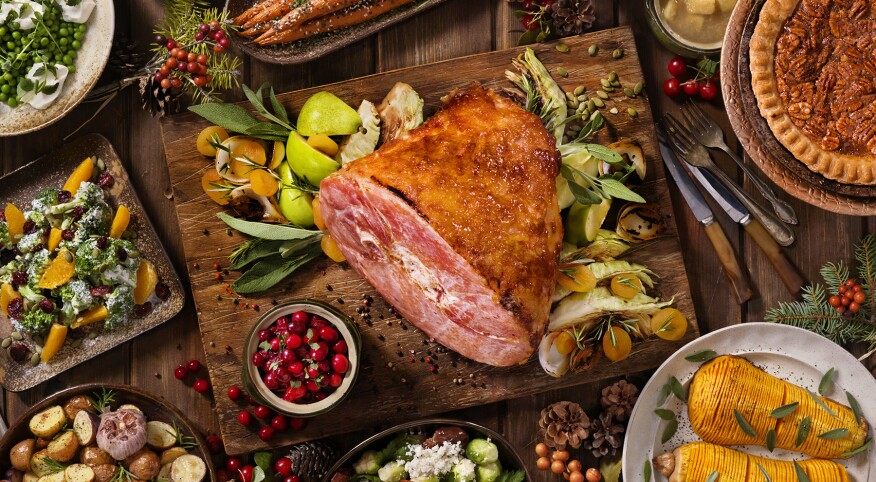The temperatures fall. The holidays approach. I crave homemade soups and stews. Don’t you? My go-to is gumbo. Just getting out my gleaming stainless stockpot and starting the roux serves up a buffet of sensory memories: Layers of ingredients begin to release their scents and whisper stories.
I was reared by my Louisiana-born single father. The spicy stew he lovingly cooked was a highlight of holiday gatherings. “The roux should be the color of mahogany,” he would eventually tell me. By then, I was grown enough to keep his secrets safe, watching as he simmered the silky mixture of flour and fat that luxuriously deepens the flavor of low-country soups and sauces.
While Dad stirred, the contents of the pot changed color, darkening from alabaster to cream to golden brown and finally to a rich, deep tone. This signaled it was ready to merge into the mélange of textures, hues, flavors and cultures that make up this treasured dish. The loved ones who have always enjoyed gumbo around our holiday tables also reflect a range of shades and histories.
Giving thanks for gumbo
My family, like our special-occasion gumbo, is a delicious mashup. Unique cultures have been blended by marriage, stirred up by divorce, seasoned by travel, fortified by religion, made thicker by resilience and preserved, when needed, by a pinch of superstition. But that’s part of what makes the holidays my favorite time of year.
My gumbo recipe has changed a bit — no sausage and chicken since my current husband and I are now vegetarian. But I still do as Dad taught me. As his sisters and mother taught him. Add the aromatic “holy trinity” of onions, peppers and celery. Stir in powdered sassafras leaves, known as gumbo filé.
The smell of that smoky French-African blend makes me yearn for long chats with Dad. He passed in 2018. I miss sitting in his kitchen drinking Cabernet or Malbec, snacking on roasted peanuts. We’d lick the salt from our fingers and talk about life.
Loss and layer cake
I was 8 the first time I tasted gumbo. My grandmother, Mama Agnes, cooked a pot when I visited Port Arthur, Texas, with my dad. My uncle Robert, picking us up at the airport, broke the news to his brother that their Aunt Lou had been murdered.
Aunt Lou had brought up my father from middle school until he went off to Xavier University. As my uncle told it, some men robbed the furniture store where she worked. They’d shot Lou, Agnes’ beloved only sister. After their arrest, according to locals’ talk, the thieves were surprised to learn that the “white woman” they thought they’d killed was, in fact, a light-skinned Creole woman born in Oklahoma.
Mama Agnes stirred love into that pot of gumbo, perhaps finding comfort in mindful attention to the ritual. She also baked a six-layer vanilla cake for me. My dad had nine siblings, and I was one of dozens of grandchildren. But my grandmother made sure I felt special that day, sitting in her kitchen, sampling chocolate icing to sweeten the sadness.
Miracles and matzo meal
Traditionally, Jewish families eat latkes (Yiddish for pancake) during Hanukkah, the festival of lights. But since I lived with my lapsed Catholic, divorced dad and not my English-born, Jewish mother as a kid, I didn’t enjoy them until later in life. My first husband, raised in a Reform Jewish household, had discarded his religious beliefs, but he held fast to his Jewish culture. So, as soon as our son was old enough to understand, we created traditions. And that meant eating potato latkes, lighting the menorah for eight nights and giving our son small gifts.
Now, I usually avoid fried food, so over the years, I’ve tried baking or pan-searing latkes. A couple of times, as a shortcut, I bought them frozen from Trader Joe’s. But, truthfully, latkes are never as good as when you make them the traditional way, like my mother did when we visited her with our son when he was 5. “Why weren’t you around to do that for me when I was a kid? I wanted to ask her at the time.
Mom pulled out her heavy cast-iron pan, glazed with oil from years of use, and her yellow Pyrex mixing bowl. She shredded the potatoes and the onions, holding a piece of bread in her mouth to keep her eyes from tearing up. She bound the mixture with matzo meal and eggs, formed them into patties and fried them. The smell of grease got into my hair and clothes. Today, whenever I lay hot homemade latkes on paper towels to drain, I’m transported to her kitchen. I am warmed by the memory of Mom smiling at my little boy as he dipped them into ketchup and sour cream.
Though our relationship was strained, I’m grateful to have made peace with my mom, Ruth, before her death of a heart attack in 2006. Forgiving my mother changed my life in miraculous ways. Every Hannukah (or whenever I feel like comfort food), I try to replicate her recipe. I invite my son, now 27, over for dinner. We talk about our memories of Ruth, including the day she made latkes for him.
Glazed ham and good memories
The funny thing is, as much as my mother loved Hanukkah, she loved Christmas even more. She loved the gifts, the tree and collecting boxes and boxes of ornaments, which I inherited. I’ve placed them on every tree since. Another Christmas tradition has been retired, however. Until I stopped eating meat, and before my son left home for college, the holiday meal always included honey-baked ham. One year, my dad tried to pass off a low-sodium version, his attempt at considering everyone’s health, mostly his own. But hard as we all tried to stifle our giggles and grimaces, ham without salt and a sweet brown-sugar glaze just wasn’t the same.
Blessings and black-eyed peas
New Year’s Day, the superstition goes, must include black-eyed peas or luck will be bad all year long. Many Black families observe this tradition, and my dad never let a New Year’s Eve go by without preparing the Southern delicacy.
I wouldn’t dream of doing otherwise, though I omit Dad’s andouille sausage. I rinse and soak the beans in the morning. By the time friends and family arrive, their savory goodness fills the air and we’ve got jazz playing and a football game on mute.
Early in our marriage, my husband and I frantically scoured Los Angeles for black-eyed peas. You would have thought the survival of our newly blended family depended on serving his two sons and my son this dish. Scoreless after four grocery stores, we anxiously implored an older Black employee at Ralph’s supermarket to search the storeroom. He understood and returned with several bags. My husband shook his hand. I wanted to hug him. He had helped ensure good luck for our next generation and hope for a fruitful future.
I’ve evolved and adapted holiday traditions over the years. I miss my dad, my mom and my grandmothers, but I feel their loving presence every time I stand at the stove and keep their recipes alive.

Getty Images










